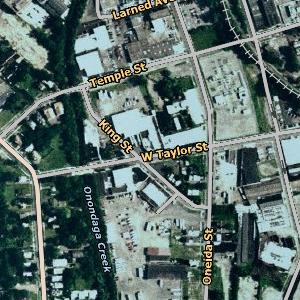« me on the tube | Main | policies for youth civic engagement »
April 15, 2008
imagining a new college
This is part of a largely abandoned section of my home town of Syracuse, NY. It's very close to downtown and there are some lovely Victorian houses in the neighborhood, mostly boarded up today. A lot of it consists of empty parking lots where once there were factories. I'm surprised that this aerial shot makes it look so green. Most of the green areas must be overgrown but abandoned lots.

Imagine if a government or private donor had the resources to found a new college or university. Such an institution could be designed to create a vibrant new urban neighborhood in a place like this--enriched by students and faculty but not reserved for them alone. To create such a community, planners should harness and direct market energies, and thereby magnify the impact of their investment.
Here's one way to do this: Obtain most or all of the property, perhaps with some use of eminent domain. Select some non-contiguous blocks in which to build campus buildings. Each block could be designed by a different architect in order to promote variety. At the same time, each block would share some common features. They would all provide a mix of student residences, some apartments for faculty and staff, spaces for eating and studying, and classrooms. I like to imagine all these blocks being built around central courts, and each one might have a tower to create a dramatic skyline.
Then the remaining blocks could be sold or leased to developers. The college or university could use its market leverage to select proposals that contributed variety and quality of design. It could even impose unusual zoning rules, such as requiring developers to build a public inner courtyard in each block. If every courtyard opened to the street in the middle of every block, pedestrians could cross the neighborhood from court to court while traffic passed on the streets.
I'd keep the traditional street plan and retain any historic buildings and major trees. If new streets had to be laid out, I would make them narrow in order to concentrate foot traffic, slow cars, and generate a feeling of energy.
I suppose there are two basic models for universities, with various hybrids and exceptions. One is a park-like campus with the buildings set on lawns and connected by paths or private roads. The other is an urban neighborhood with academic buildings and student residences scattered throughout--the standard European model, which we also see at Boston University, the New School, and some other American institutions. I do not prefer the European model overall; both can be nice. I do think that integrating a new university into an urban neighborhood would be a powerful way to spur economic development and turn abandoned property into valuable real estate.
April 15, 2008 7:03 AM | category: academia | Comments